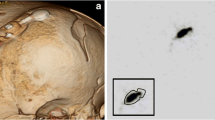Abstract
Background
To our knowledge, the sensitivity of plain radiography, known as the shunt series, in diagnosing an etiology of ventriculoperitoneal (VP) shunt malfunction in children has not been previously investigated.
Objective
To determine the accuracy of plain radiography in diagnosing VP shunt failure in children in whom shunt malfunction is clinically suspected.
Materials and methods
We retrospectively reviewed the charts of 238 children who had undergone plain radiographic examination for evaluation of clinically suspected VP shunt failure over a 5-year period. The results were compared with those of CT, MRI, and nuclear cisternography.
Results
Just 6.72% of patients demonstrated plain radiographic signs of shunt failure. Of patients with normal plain radiographs, 43% demonstrated shunt abnormalities on CT, MRI or cisternography. Statistical analysis indicated that no more than 10.46% (P < 0.05) of plain radiographs showed signs of failure and that the sensitivity of plain radiography for the detection of VP shunt failure is no higher than 31%. Furthermore, there was poor agreement between the results of plain radiography and those of CT, MRI and cisternography.
Conclusion
Children with clinically suspected VP shunt failure should proceed directly to cross-sectional or nuclear imaging, as plain radiographic examinations have low sensitivity and significant false-negative rates for detecting shunt abnormalities in all-comers. Use of the shunt series should be limited to patients who specifically have suspected mechanical causes of shunt failure.
Similar content being viewed by others
References
Von Winning H (1987) Portrayal of pathological symptoms in pre-Columbian Mexico. Pearson Museum, Southern Illinois University School of Medicine, Springfield, IL
Adams F (1925) Hippocrates: the genuine works of Hippocrates, vol 1. William Wood, New York, pp 353–391
Rekate HL (1994) Pediatric neurosurgery. Saunders, Philadelphia, pp 202–220
Townsend C (2004) Sabiston textbook of surgery. Saunders, Philadelphia, p 2175
Coffin JG (1825) Domestic medicine, or, a treatise on the prevention and cure of diseases by regimen and simple medicines. Phelps & Farnham, Boston
Hunter TB (2004) Medical devices of the head, neck, and spine. Radiographics 24:257–285
Bondurant CP, Jimenez DF (1995) Epidemiology of cerebrospinal fluid shunting. Pediatr Neurosurg 23:254–259
Pudenz RH (1981) The surgical treatment of hydrocephalus: an historical review. Surg Neurol 15:15–26
Browd S, Ragel B, Gottfried O (2006) Failure of cerebrospinal fluid shunts. Part I: obstruction and mechanical failure. Pediatr Neurol 34:83–92
Drake J, Kestle J, Milner R et al (1998) Randomized trial of CSF shunt valve design in pediatric hydrocephalus. Neurosurgery 43:294–305
Browd S, Gottfried O, Ragel B et al (2006) Failure of cerebrospinal fluid shunt. Part II: overdrainage, loculation, and abdominal complications. Pediatr Neurol 34:171–176
Dominguez CJ, Tyagi A, Hall G et al (2000) Sub-galeal coiling of the proximal and distal components of a ventriculo-peritoneal shunt. An unusual complication and proposed mechanism. Childs Nerv Syst 16:493–495
Woerdeman PA, Hanlo PW (2006) Ventriculoperitoneal shunt occlusion due to spontaneous intraabdominal knot formation in the catheter. Case report. J Neurosurg 105(3 Suppl):231–232
Sami A, Ait Ben Ali S, Choukry M et al (1995) Anal migration of ventriculo-peritoneal shunt catheter. Apropos of 3 cases. Neurochirurgie 41:315–318
Goetz CG (2003) Textbook of clinical neurology, 2nd edn. Saunders, Philadelphia, p 556
Goeser CD, McLeary MS, Young LW (1998) Diagnostic imaging of ventriculoperitoneal shunt malfunctions and complications. Radiographics 18:635–651
Garton HJ, Kestle JR, Drake JM (2001) Predicting shunt failure on the basis of clinical symptoms and signs in children. J Neurosurg 94:202–210
Griffey T, Ledbetter S, Khorasani R (2006) Yield and utility of radiographic shunt series in the evaluation of ventriculoperitoneal shunt malfunction. Acad Emerg Med 13(Suppl 1):S139
Murtagh FR (1979) Cerebrospinal fluid shunt function and hydrocephalus in the pediatric age group: a radiographic/clinical correlation. Radiology 132:385–388
Author information
Authors and Affiliations
Corresponding author
Rights and permissions
About this article
Cite this article
Desai, K.R., Babb, J.S. & Amodio, J.B. The utility of the plain radiograph “shunt series” in the evaluation of suspected ventriculoperitoneal shunt failure in pediatric patients. Pediatr Radiol 37, 452–456 (2007). https://doi.org/10.1007/s00247-007-0431-3
Received:
Revised:
Accepted:
Published:
Issue Date:
DOI: https://doi.org/10.1007/s00247-007-0431-3




